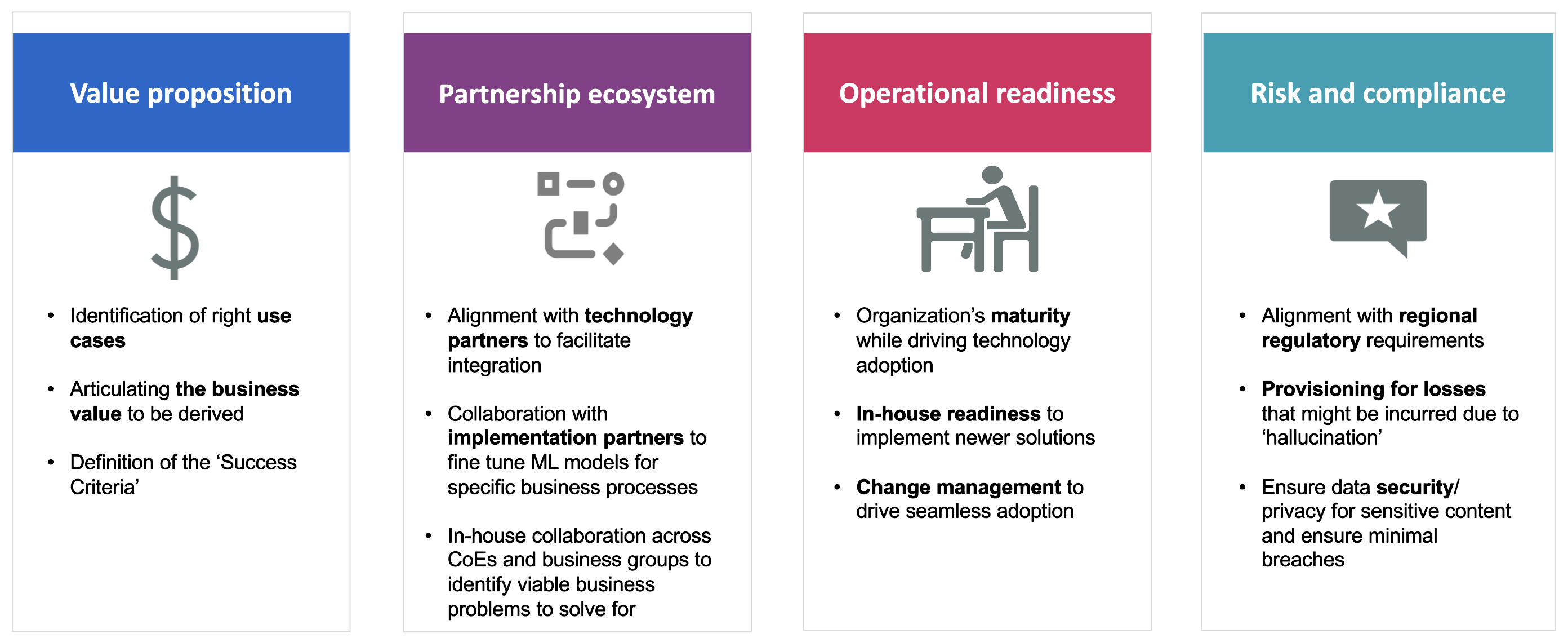How business leaders can maximize the potential of Generative AI
Share at:

Over the last decade, investment in innovative technologies has sharply risen. According to a 2022 McKinsey survey, “AI adoption has more than doubled in the last five years,” and “the level of investment in AI has increased alongside its rising adoption.”
While previous artificial intelligence (AI) business initiatives mostly leveraged analytical AI or symbolic AI capabilities, the latest development in the field of Generative AI has taken the world by storm.
Business leaders increasingly view Generative AI as a powerful tool for innovation and problem solving. Generative AI can be used to automate complex processes, create personalized experiences for customers, and even generate new ideas and designs. There are already use cases in industries such as fashion, design, media, and entertainment, where the creation of new art, music, and assets by AI was previously unimaginable.
However, business leaders must be aware of the potential pitfalls of Generative AI and ensure proper measures are taken to mitigate them.
Hallucinations - Generative AI may produce inaccurate or misleading results, especially when dealing with complex data or images. These are known as "hallucinations." They can be a significant drawback in highly regulated industries like healthcare or financial services, where consistency and accuracy are crucial.
Deepfakes - Generative AI algorithms can produce media based on patterns learned from existing data. However, their misuse can lead to the creation of deepfakes—such as manipulated videos or images—that spread misinformation. The creation of highly realistic fake media could even lead to blackmail and reputational damage.
Transparency - Generative AI can be opaque, making it difficult to understand how it arrives at decisions or outputs. This lack of transparency can lead to mistrust and may make it difficult to explain its results to stakeholders.
Legal and ethical issues - As with any AI technology, Generative AI raises legal and ethical issues related to data privacy, intellectual property, and bias. Business leaders must comply with relevant laws and regulations, as well as address any ethical concerns related to using generative AI.
Security and privacy concerns - Generative AI relies on users sharing large amounts of data to generate new content. While this gives Generative AI models more data to train and improve on, it also makes the data vulnerable to security breaches and data privacy issues. Executives need to ensure they have appropriate security measures in place to protect their data and that of their customers.
While businesses are addressing these challenges, remember that Generative AI is only one enabler of end-to-end digital transformation. Siloed business initiatives of Generative AI can only provide one piece of the larger puzzle. Fortunately, with integrated platforms like the UiPath Business Automation Platform, the business value of Generative AI is elevated through end-to-end use cases.
Generative AI functions as the ‘brain’ behind the digital transformation ecosystem; AI-powered automation serves as the requisite ‘muscle’ to act on the generated insights.
Realizing the potential Generative AI offers, business leaders are increasingly keen to adopt it into their broader digital transformation roadmaps. As guidance, the following should be considered:

Value proposition
While it’s easy to be distracted by the buzz surrounding Generative AI, focus on value is key.
While customer service is one key area being explored for Generative AI deployment, there are other opportunities for executives to consider.
For instance, using automation workflows and Generative AI, financial institutions can automatically flag suspicious transactions and analyze patterns to identify potential fraud. This can save valuable time for human analysts and increase the accuracy of fraud detection. Once the analysis is complete, UiPath Robots can help automate the population of respective flags in the underlying applications.
Similarly, while performing demand forecasting, Generative AI can be used to analyze historical sales data and other relevant factors, such as weather patterns, to generate more accurate demand forecasts. This can help businesses optimize their inventory levels and reduce waste, while automation workflows can be used to automatically adjust inventory levels and reorder products when necessary.
As always, while exploring newer technologies, business leaders need to be watchful of their spend and define success criteria early in their adoption roadmap.
Partnership ecosystem
As has already been established, deploying Generative AI in a silo won’t suffice. It’s therefore vital to build a collaborative partnership ecosystem—internal and external. Additionally, executives need to consider build vs buy approaches towards deploying Generative AI to guide them in forging partnerships at the right level.
Businesses also need to identify the right technology partners to help them develop end-to-end solutions. In addition, organizations should partner with implementation services providers to access outside expertise and skills. The right partnerships ensure businesses can launch their offerings in a timely manner.
Furthermore, executives should encourage internal business groups to collaborate effectively to ensure the best use cases are brought to the table.
Operational readiness
Business leaders need to ensure they have the necessary maturity level required to adopt Generative AI. This includes assessing if their underlying systems are scalable, secure, and can integrate with Generative AI and automation capabilities. In addition, executives need to have the necessary data management processes in place. They also need to ensure data quality and security, and establish data governance processes to make sure that data is managed effectively.
In time, businesses also need to establish clear governance and change management processes to ensure that automation and Generative AI initiatives align with business goals and that stakeholders are prepared for the changes. This includes establishing roles and responsibilities, creating communication plans, and providing training and support to employees.
Governance, risk, and compliance
This pillar focuses on ensuring that the business is compliant with relevant regulations and standards. The risks associated with Generative AI should also be identified and managed effectively. This includes establishing clear policies and procedures for managing data, ensuring that the technology is compliant with relevant regulations, and creating contingency plans in case of unexpected events. Business leaders should work closely with legal and compliance teams to ensure all stakeholders are aware of the risks and can effectively manage them during Generative AI adoption.
Summary
When it comes to Generative AI, business leaders don't have the option to watch and wait with their adoption strategy. However, the pillars outlined in this blog post should allow them to keep a keen eye on their business problems and objectives.
It’s important to remember one thing. While the technology is the same for everyone, adoption and execution will help businesses differentiate their offerings and transform their operating model.
UiPath has long been at the forefront of AI-powered automation. Recognizing the potential of Generative AI, UiPath has launched multiple integrations. See how your business can rapidly gain insight and work more efficiently with our Ask GPT activity.
We invite you to join us this October for UiPath FORWARD VI in Las Vegas, Nevada. We’re bringing together the world’s leading automation and AI experts. You’ll hear how other executives are innovating in the enterprise with AI-powered automation. Register now.

(Previously) APAC Sales Engineering Hub Lead, UiPath
Get articles from automation experts in your inbox
SubscribeGet articles from automation experts in your inbox
Sign up today and we'll email you the newest articles every week.
Thank you for subscribing!
Thank you for subscribing! Each week, we'll send the best automation blog posts straight to your inbox.



